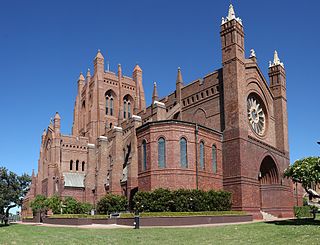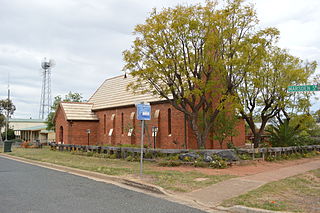
St Andrew's Cathedral is a cathedral church of the Anglican Diocese of Sydney in the Anglican Church of Australia. The cathedral is the seat of the Anglican Archbishop of Sydney and Metropolitan of New South Wales. The position of Dean of Sydney has been held by the Very Reverend Sandy Grant since 9 December 2021.

Christ Church St Laurence is an Anglican church located at 814 George Street, near Central railway station and Haymarket, in Sydney, New South Wales, Australia. It is the principal centre of Anglo-Catholic worship in the city and Diocese of Sydney, where the Anglicanism is predominantly Evangelical in character. Anglo-Catholicism is manifested at Christ Church St Laurence by an emphasis on the sacraments, ritual, music and social action, all of which have been prominent features of Anglo-Catholicism since the 19th century.

The St Saviour's Cathedral is the heritage-listed cathedral church of the Anglican Diocese of Canberra and Goulburn in Goulburn, Goulburn Mulwaree Council, New South Wales, Australia. The cathedral is dedicated to Jesus, in his title of Saviour. The current dean is the Very Reverend Phillip Saunders. It was added to the New South Wales State Heritage Register on 20 April 2009.

The Cathedral Church of Christ the King, also called Christ Church Cathedral, is an Australian cathedral in Newcastle, New South Wales. It is the cathedral church of the Diocese of Newcastle in the Anglican Church of Australia. The building, designed by John Horbury Hunt in the Gothic Revival style, is located on a hill at the city's eastern end in the suburb called The Hill. It was added to the New South Wales State Heritage Register on 28 June 2011.

The St John's Anglican Church, officially known as the Church of St. John the Evangelist, is a heritage-listed active Anglican church located at 120 Darlinghurst Road in the Sydney suburb of Darlinghurst, New South Wales, Australia. The church and its associated buildings were added to the New South Wales State Heritage Register on 2 April 1999. It was also listed on the former Register of the National Estate.

St Peter's Cathedral is an Anglican cathedral with heritage-listed building and grounds at 122 Rusden Street, Armidale, Armidale Regional Council, New South Wales, Australia. It is the mother church of the Anglican Diocese of Armidale. and the seat of the Anglican Bishop of Armidale. The cathedral was designed by John Horbury Hunt and Bishop James Francis Turner and built from 1871 to 1938. It is also known as the Anglican Cathedral Church of St Peter Apostle and Martyr. It was added to the New South Wales State Heritage Register on 12 March 2014.

Christ Church Cathedral is a heritage-listed Anglican cathedral complex at Duke Street, Grafton, Clarence Valley Council, New South Wales, Australia. The cathedral was designed by John Horbury Hunt and built from 1874 to 1884 by Reynold Brothers (brickwork) and G. J. T. Lawson (woodwork). It is also known as Cathedral Church of Christ the King and Grafton Anglican Cathedral. The property is owned by the Anglican Diocese of Grafton. It was added to the New South Wales State Heritage Register on 14 March 2003.

St Peter's Anglican Church is a heritage-listed Anglican church located at 187-209 Princes Highway, St Peters, in Sydney, New South Wales, Australia. It is one of the oldest churches in Sydney. Designed by Thomas Bird, the church is sometimes referred to as St Peter's Church, Cooks River, as it is located in the Anglican Parish of Cooks River, New South Wales. The church is listed on the NSW State Heritage Register and on the Register of the National Estate.

The Garrison Church is a heritage-listed active Anglican church building located at Argyle Street in the inner city Sydney suburb of Millers Point in the City of Sydney local government area of New South Wales, Australia. It was designed by Henry Ginn, Edmund Blacket and built from 1840 to 1846 by Edward Flood and George Patton. It is also known as Holy Trinity Anglican Church and Hall. The property is owned by Anglican Church Property Trust and was added to the New South Wales State Heritage Register on 2 April 1999.

St Paul's Anglican Church is a heritage-listed church at 124 Brisbane Street, Ipswich, City of Ipswich, Queensland, Australia. It was built from 1855 to 1929. It was added to the Queensland Heritage Register on 21 October 1992.

St Michael's Cathedral is a heritage-listed Anglican cathedral at Church Street, Wollongong, City of Wollongong, New South Wales, Australia. It is the principal Anglican church in the city of Wollongong and the mother-church of the Bishop of Wollongong. It was designed by Edmund Blacket and built from 1858 to 1859. The property is owned by the Anglican Church Property Trust. It was added to the New South Wales State Heritage Register on 2 April 1999.

St Alban's Anglican Church is a heritage-listed Anglican church located at Hunter Terrace, Muswellbrook in the Muswellbrook Shire local government area of New South Wales, Australia. It was designed by Sir George Gilbert Scott and built from 1864 to 1869 by Edmund Blacket, supervised by John Horbury Hunt. It is also known as St. Alban's Anglican Church and St Albans Church. The property is owned by the Trustees of the Anglican Diocese of Newcastle. The church was added to the New South Wales State Heritage Register on 2 April 1999.

St Mary's Anglican Church is a heritage-listed Anglican church and associated facilities located at 240 Birrell Street, Waverley, in the Waverley Municipality, Sydney, New South Wales, Australia. The church was designed by Edmund Blacket and built between 1863 and 1864. It is very well known and sought after as a place to be married and is popular for funerals. The building is also notable due its pipe organ, designed and built by August Gern. The property is used for ministry by the Anglican Parish of Bondi and Waverley, which is an amalgamation of two previous Parishes ; The first Rector of St Mary’s Waverley, Rev Stanley Mitchell, was a keen Evangelical and although he used traditional Anglican liturgy was “low church” like most of Sydney Diocese. However there has been a long history of more “High” Anglicanism and Anglo Catholic theological underpinnings. Since 2014, the church has returned to a strongly evangelical base while running a very strong traditional 1662 prayer book communion service every Sunday. It also has less traditional al services to accommodate more contemporary congregations.

The All Saints' Anglican Church is a heritage-listed Anglican church located at McDonnell Street, Condobolin in the Lachlan Shire local government area of New South Wales, Australia. The church was possibly designed by Edmund Blacket and was built from 1878 to 1879 by Mr Brinsmead. It is also known as All Saints Anglican Parish Church. The property is owned by the Anglican Diocese of Bathurst. It was added to the New South Wales State Heritage Register on 2 May 2008.

St James' Anglican Church is a heritage-listed Anglican church precinct at 19 Tank Street, Morpeth, City of Maitland, New South Wales, Australia. The original design was attributed to Edward Charles Close, with later additions by Edmund Blacket and John Horbury Hunt and built from 1837 to 1875 by Edward Charles Close and James Sherwood. The precinct also includes the St. James' rectory and parish hall. The property is vested in the trustees of church property for the Diocese of Newcastle. It was added to the New South Wales State Heritage Register on 27 January 2017.

St Peter's Anglican Church and Glebe Cemetery are a heritage-listed Anglican church and closed cemetery in East Maitland, New South Wales, Australia. The church is at 49 William Street while the cemetery is approximately 1.2 km (0.7 mi) away, approximately 400 m (1,312 ft) beyond the end of George St, also in East Maitland. The church was designed by Cyril and Arthur Blacket and built from 1884 to 1886. The cemetery is also known as Glebe Gully Burial Ground and Glebe Paddock. It was added to the New South Wales State Heritage Register on 31 August 2012.

St Mary's the Virgin Anglican Church is a heritage-listed Anglican church at 66 Church Street, Maitland, City of Maitland, New South Wales, Australia. It was designed by Edmund Blacket. It was added to the New South Wales State Heritage Register on 2 April 1999.

St John the Evangelist Church is a heritage-listed former Aboriginal land, squatting run, and farm village and now dual-denomination Anglican and Presbyterian church located at Main Street, Wallerawang, City of Lithgow, New South Wales, Australia. It was designed by Edmund Blacket and Blacket and Sons, and built from 1880 to 1881 by George Donald. It is also known as St. John the Evangelist Church and Church of St. John the Evangelist. It was added to the New South Wales State Heritage Register on 10 September 2004.

St Matthew's Anglican Church is a heritage-listed Anglican church building located at Moses Street, Windsor, City of Hawkesbury, New South Wales, Australia. It was designed by Francis Greenway and built from 1817 by convict labour. The property is owned by the Anglican Church Property Trust. It was added to the New South Wales State Heritage Register on 2 April 1999.

St John the Evangelist Church is a heritage-listed Anglican church at 2985 Paynes Crossing Road, Wollombi, City of Cessnock, New South Wales, Australia. It was designed by Edmund Blacket and built from 1846 to 1864.





















